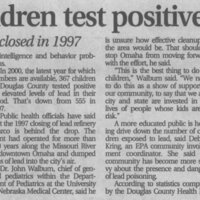Narratives of Hope: Declining Lead Levels
Dublin Core
Title
Narratives of Hope: Declining Lead Levels
Subject
Lead levels in children in Omaha in the early 2000s, and the impact of these tests on the beginning of the Superfund project
Description
Despite concerns for the rate of the project’s progress, it is undeniable that some progress is being made in Omaha in the early days of the Superfund site. This article from the Fremont Tribune, published in January of 2002, discusses the progress made in the Omaha area and takes on an optimistic outlook on work completed. Narratives in communities at the time were by no means wholly negative or positive, and articles such as “Fewer children test positive for lead poisoning” serves as important comparative material to the Argus-Leader’s take on Superfund in Omaha. For instance, the article focuses on the declining rate of lead poisoning in Omaha, instead of opening with a case of severe lead poisoning in a child... In 1997, 555 children in Douglas County tested positive for elevated blood levels, compared to a much diminished (although still very significant) 367 in 2000. The fact of most notable importance is that this article discusses uncertainty around the necessity of an Omaha EPA cleanup site: “the drop has some questioning the necessity of an Omaha cleanup project”, and cites the cost (which they list as 100 million dollars) as one reason for concern. In general, this article elucidates some schools of thought on lead pollution in Omaha at the time it was written - narratives not present in the Argus-Leader. Instead, this primary source shows that there was indeed doubt of the necessity of a cleanup, with public health officials attributing the drop in lead levels to the closing of the ASARCO plant. While it is certainly true that the closing of the plant was a first step in the right direction for Omaha public health at the time, people were unsure of the severity and effects of the lead contamination, as late as 2002. This primary source tells a different story from the 2004 Argus-Leader report, and is evidence that to at least some extent there existed entities, even in public health, who were not proponents of the superfund cleanup. Dr. John Walburg, chief of general pediatrics at the University of Nebraska Medical Center, even indicated he was unsure of how effective the cleanup project under the EPA would be. Though Dr. Walburg was still a proponent of the project, stating: “We need to do this as a show of support to our community, to say that we as a city and a state are invested in the lives of people whose kids are at risk”.
The Fremont Tribune also adds important distinctions to our timeline, indicating lead cleanup under Superfund and EPA was still in the very early stages as of 2002.
The Fremont Tribune also adds important distinctions to our timeline, indicating lead cleanup under Superfund and EPA was still in the very early stages as of 2002.
Creator
Lincoln Journal Star
Source
Lincoln Journal Star, Newspapers.com
Publisher
Lincoln Journal Star
Date
January 7th, 2002
Contributor
Ben Schauer
Format
Digital Media
Language
English
Still Image Item Type Metadata
Original Format
Print Newspaper
Citation
Lincoln Journal Star, “Narratives of Hope: Declining Lead Levels,” History of Environmental Inequalities, accessed May 19, 2024, https://steppingintothemap.com/inequalities/items/show/140.
Embed
Copy the code below into your web page
